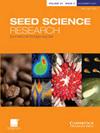哥伦比亚安第斯山地森林14种种子解剖及休眠分类
IF 1.9
3区 生物学
Q2 PLANT SCIENCES
引用次数: 0
摘要
种子休眠是世界各地用来帮助了解植物物种生态动态的一个关键特征,然而,在一些生态系统中,如哥伦比亚的安第斯森林,对休眠类别的识别仍然知之甚少。为了解决这一问题,我们利用显微切片、光镜和扫描电镜对14种植物的种子和果实的形态、解剖和休眠类别进行了描述。原生拓荒者有5种表现为形态生理休眠,3种表现为物理+生理休眠,2种表现为物理休眠,入侵种有2种表现为生理休眠。只有Cecropia属的种具有PY + PD,这是由瘦果的解剖结构促进的。在分析的物种中,85%的物种表现出休眠状态,并遵循世界上其他热带山地生态系统的模式。瘦果的解剖结构和种子休眠的发育在柏树物种促进安第斯生态系统自然更新的能力中起着重要作用。此外,种子休眠可能促进了哥伦比亚中部科迪勒拉安第斯森林中刺蒿和欧洲刺蒿的高入侵性。本文章由计算机程序翻译,如有差异,请以英文原文为准。
Seed anatomy and dormancy class of 14 species from the Andean montane forests of Colombia
Seed dormancy is a key trait used around the world to help understand the ecological dynamics of plant species, however, in some ecosystems such as the Andean forests of Colombia, the identification of dormancy class remains poorly known. To address this, we described the morphology, anatomy and dormancy class of the seeds and fruits of 14 species using microtome sections, light microscopy and scanning electron microscopy. Five native pioneer species showed Morphophysiological Dormancy, three Physical Dormancy + Physiological Dormancy and two Physical Dormancy, whereas two invasive species showed Physiological Dormancy. Only the species of the genus Cecropia had seeds with PY + PD that was promoted by the anatomical structure of the achenes. Of the analysed species, 85% showed dormancy and followed a pattern like other tropical montane ecosystems in the world. The anatomy of achenes and development of seed dormancy play important roles in the capacity of Cecropia species to contribute to the natural regeneration of Andean ecosystems. Additionally, seed dormancy may promote the high invasiveness of Thunbergia alata and Ulex europaeus in the Andean forests of the Central Cordillera of Colombia.
求助全文
通过发布文献求助,成功后即可免费获取论文全文。
去求助
来源期刊

Seed Science Research
生物-植物科学
CiteScore
3.60
自引率
4.80%
发文量
23
审稿时长
>12 weeks
期刊介绍:
Seed Science Research, the official journal of the International Society for Seed Science, is a leading international journal featuring high-quality original papers and review articles on the fundamental aspects of seed science, reviewed by internationally distinguished editors. The emphasis is on the physiology, biochemistry, molecular biology and ecology of seeds.
 求助内容:
求助内容: 应助结果提醒方式:
应助结果提醒方式:


